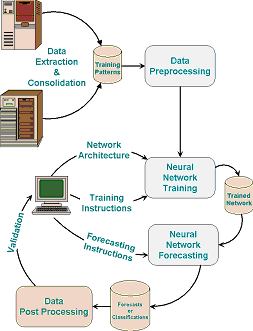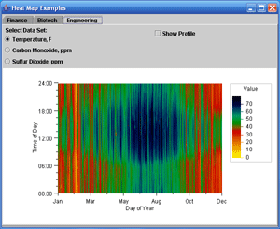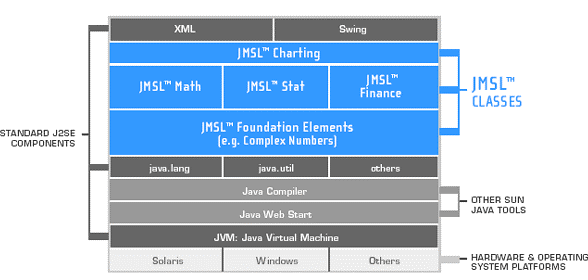|
Numerical Analysis and Visualization in Business
The JMSL Library is the broadest collection of mathematical, statistical, financial, data mining and charting classes available in 100% Java. It is the only solution for Java programmers, which combines integrated charting with the reliable mathematical and statistical functionality of the industry-leading IMSL™ Numerical Library algorithms.
Today, business decisions need to be based on powerful and timely business analytics - leveraging all the rich data collected over the years. This blend of advanced numerical analysis combined with visualization on the Java platform allows organizations to gain insight into valuable data and share analysis results across the enterprise quickly for more insightful and timely decision-making.
Advanced Forecasting with Neural Network Technology
The JMSL Library now includes neural network technology that adds to the broad selection of existing data mining, modeling and prediction technologies available across the IMSL Family of products. These neural network forecasting classes have tremendous potential for businesses by offering the ability to build predictive models using historical data and training the network to optimize the model over time as more information is obtained.
One of the most powerful features of this set of neural network forecasting classes is the ability to mimic human problem-solving processes by applying knowledge gained from historical data to new problems, and fine-tuning the forecasting accuracy over time. With this ability, businesses can extract information such as historical cost data and apply this to the neural network to forecast future costs with increasing degrees of accuracy.

The neural network training application integrates the neural network data-mining process into four steps: data preprocessing, network training, network forecasting, and data post processing.
Powerful Statistics for Leading Edge Applications
The latest release of the JMSL Numerical Library, version 3.0, includes new statistical algorithms that will assist statisticians and analysts with applications in areas such as bioinformatics and life sciences where data sets tend to be extremely large and complex.
Another important addition to the JMSL Library is the inclusion of the heat map chart type, which is used in a number of areas, including life sciences for displaying two-dimensional arrays of color values. The heat map chart adds to an already strong and broad charting offering in the JMSL Library and helps analysts in a number of fields develop advanced numerical applications in Java.

Plot Displaying Measured Temperature Over the Course of an Entire Year
The Architecture
Applications built using Java™, by nature, are flexible and extremely portable. Due to Java's platform independence, these applications run over the Web or on a server with strong networking capabilities and the provision for collaboration across the enterprise. Most importantly, Java is easy to use, allowing for rapid development and deployment, which reduces costs and improves productivity.
With its JMSL™ Numerical Library for Java Programmers, Visual Numerics® has brought all of the benefits inherent in the Java language a new dimension by adding robust analytics to its broad set of capabilities. Visual Numerics has extended the foundation of the Java language to accommodate new classifications for numerical analysis, delivering the only fully supported and documented Java Numerics solution with the reliability of the industry-standard IMSL™ Numerical Library.

The Leader in Java Numerical Analysis
The JMSL Library continues to be the leader providing robust data analysis and visualization technology for the Java platform. The JMSL Numerical Library Version 3.0 provides a fast, scalable framework for tailored analytical applications. With new neural network algorithms, data mining pre- and post-processing algorithms, and additional advanced statistical algorithms, analysts in the fields of finance, business analytics, bioinformatics and life sciences can tailor applications for data mining and predictive analysis of complex data.
|









